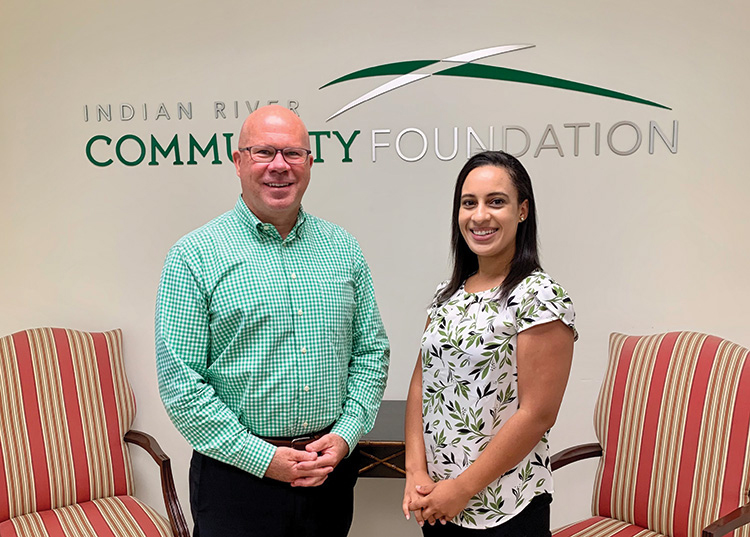
With the launch of Indian River Indicators earlier this month, the Indian River Community Foundation has added a new tool to its arsenal of community resources that can be utilized by the nonprofit sector and philanthropists as well as community leaders and policy makers to aid them in their decision-making processes.
“We believe that data can be used to make a difference,” said Jeff Pickering, Community Foundation CEO. “We live in one of the most generous counties in America. And people are compelled to give because they’re caring and they’re thoughtful and intelligent. We want to continue to promote more of that. And more of that at a higher level, oftentimes requires better data and more information.”
Pickering said the Community Foundation has built its reputation on providing excellent client services and helping people carry out their charitable giving. With assets approaching $100 million and another $100 million in planned gifts, the IRCF continues to be one of the fastest growing community foundations in the country.
“Indian River Indicators supports our mission of building a better community through donor advised philanthropy,” said Pickering.
“And it’s a program that originated after the publication and distribution of our Community Needs Assessment.”
The Needs Assessment, published in 2020, reflected data collected throughout the county from June through August 2019 in five areas – children, economic opportunity, health, housing and seniors.
Among the takeaways from the Needs Assessment is that the community is growing, particularly the senior population, and it is becoming more diverse. However, the wealth gap – the difference between the top 1 percent and the other 99 percent – is among the 10th largest in the country.
“It’s a Top Ten list you don’t want to be on,” said Pickering. “That’s troubling when you think about what needs to be done in order to help people live healthy, prosperous lives.”
Overall, he said, the Needs Assessment showed where the county has been making progress and what areas of concern needed to be addressed.
Indian River Indicators, which was financed by philanthropic contributions to the IRCF, takes that data considerably further in an interactive, multi-sourced design.
Pickering explained that this new resource, which will be updated at least annually, tracks key data and information about community needs that can be used to support and sustain proven programs.
“It can also be used by community leaders to develop policy and promote promising practices, or even inspire innovation that can lead to solutions that are pertinent to the community challenges that persist,” said Pickering.
IRCF partnered with a technology firm to produce Indian River Indicators. Pickering explained that it uses publicly available data from various sources, including local, regional, state and federal open-sourced data.
“It would take us weeks to go track it down, but because it’s open-sourced the programs are written to point to those indicators and then pull the data in as soon as they’re indicated; at least annually,” said Pickering.
Indian River Indicators, accessible from the IRCF website, has a wealth of information, illustrated through charts, graphs and census track maps. The IRI dashboard provides a table of contents and an overview of the community that includes everything from total population to life expectancy.
Beneath that, sections are broken down by the Health and Prosperity of Children (0-18) and Adults (18+; and 65 and older), and each of those are further broken down by Education, Economic Opportunity and Housing & Safety.
“What’s nice about this is that it will show you the data source. Every single one of these data points has the source cited here, and when new data becomes available, the site will be updated,” said Pickering. “We hope this data makes a difference for the people who choose to use it.”
While what is currently shown is what they felt illustrated some of the most critical data, he said they can accommodate requests to have areas broken down further using a data library that has thousands of data points.
Among its takeaways, Pickering said progress has been made on some fronts, such as a rapidly declining infant mortality rate, but there is still more work to do. For example, while more children are going to school kindergarten-ready, there are far too many Black students who are not proficient in eighth-grade math.
“What that means is, if they don’t get into Algebra 1 by ninth grade and complete their math requirements, they don’t graduate. It’s a big problem that needs to be addressed,” said Pickering.
Homelessness continues to be a big challenge, and our county has almost double the state average for binge drinking and heavy-use smoking among seniors, particularly women living alone.
And while access to healthcare has increased, Indian River County does not have a service for teens and adolescents needing intensive outpatient treatment for substance abuse or mental health.
“Where philanthropy is going to play more of a role, in closing the gap on some of these challenges, is really two-fold.
“One, bringing promising practices that exist other places to Indian River County. The other one is creating the environment where more public dollars can be directed toward bigger picture community issues,” said Pickering.
“This is a resource for anybody who wants to be more effective with their philanthropy,” said Pickering. “They can use this data to make a difference in our community, with an organization or with a specific population that they care about. If you want to truly treat your giving like an investment, the data and the information about our community’s needs and the areas where you can make more of a difference, are on Indian River Indicators. They can do this on their own, or they can contact us to do that.”
For more information, visit
ircommunityfoundation.org.



